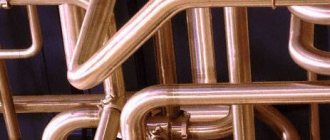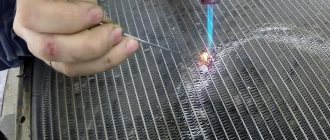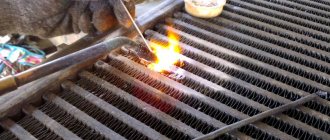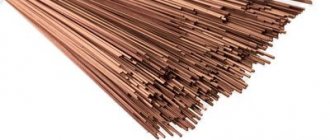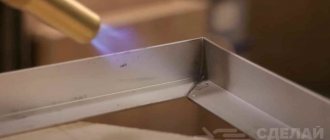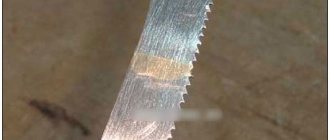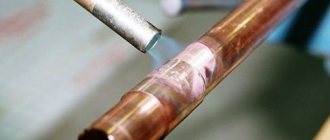Five thousand years ago, minters from Egypt discovered a new type of joining metals using the soldering method. The essence of the method is to create a connection between different metals by filling the seams with solder, which is a molten material with a melting point lower than that of the parts of the product being connected. Unlike steel, it is more expedient to connect copper parts by soldering rather than welding. This is especially important if you have to work with thin-walled copper pipes, which are widely used in heating, plumbing, gas and refrigeration systems. Even a beginner can handle this kind of work.
Features of copper pipes
The chemical composition used in the production of copper pipes consists of 99% copper, but minor impurities of tin, iron, antimony, and lead are allowed.
Copper pipes are hard (not annealed) and soft (annealed). During manufacturing, through machining, the copper material loses its natural ductility.
This property can be restored by annealing the metal, that is, heating it to 600-700 degrees and then cooling it under natural conditions. As a result of such actions, the copper pipe receives some technological advantages over solid copper. Of course, a soft pipe loses in strength, but it is much superior in ductility, which increases the value of its elongation at break by 40-60%. This means that the soft pipe can be easily bent without fear of breaking. Due to the plastic deformation of copper, such pipes can prevent the water supply from rupturing if it accidentally freezes.
Copper pipes have the following advantages:
- durability of operation;
- strength;
- ability to be easily processed;
- are not afraid of ultraviolet radiation;
- withstands the highest possible temperatures;
- operate safely under high pressure;
- have bactericidal properties;
- do not corrode;
- have high thermal conductivity and a smooth surface.
Of course, the higher cost of copper compared to other modern materials can be attributed to its disadvantages, but soldering technology allows you to save on fittings.
High pressure crimp connections
Advances in bonded crimp technology and the development of O-ring materials are allowing bonded crimp connections to be used for high pressure applications. However, high pressure systems require a slightly different jaw configuration.
The result of manufacturing a connecting unit using the 360º double crimping technique
Bonded crimp connections for low pressure piping, process piping and non-medical compressed gas lines use a single standard hexagonal pressing shape.
Higher pressure bonding crimp connections require the use of specially designed press fittings and clamping jaws to provide a 360° double crimp on the fitting.
Soldering methods for copper parts
Permanent connection of pipes at industrial facilities, as well as copper soldering at home, is carried out using two methods:
- High-temperature method - used on pipelines operated at high temperatures and under heavy load. Solder melting by this method occurs at a temperature of 600-900℃.
- Low temperature method - used for domestic systems. When using soft solder, the heating of the soldering area reaches 450℃, and for hard solder - more than 450℃.
Soldering process
It consists of performing sequential operations:
- the pipe is cut into pieces of the required sizes, which are marked for convenience - supply or return;
- a chamfer is removed from the edge;
- the edges are cleaned by 2 cm: the outer ones on the pipe, as well as the inner ones in the socket;
- Flux is applied in a strip along the cleaned surfaces (external and internal);
- the connection is assembled: the pipe is inserted into the socket;
- excess flux is removed with a paper napkin, but not completely - an edge of 1–2 mm is left;
- the burner is ignited, the flame is brought to the junction;
- the surface is heated for 10–15 seconds to a certain temperature - the flux should acquire a tin color;
- Solder is placed on top of the joint; when heated, it will be drawn into the joint and spread along the seam, filling it.
If the connection joint has not been cleared of bristles or dust, and as a result the soldered seam of the copper water pipe leaks, then the tightness can be restored using one of two methods:
Using a soldering iron
- the surface is cleaned, treated with phosphoric acid, heated with a soldering iron, and tin is applied;
- using a torch: flux is applied to the cleaned surface, heated, solder is applied, and melted.
How to properly solder copper with a gas torch
You can solder a copper tube as follows:
- Clean the soldering area with a fine file, sandpaper or wire brush.
- Grind rosin and sprinkle the soldering area.
- Heat the tube over a gas flame until the rosin melts.
- Place POS-30 or 40 solder and melt it with a soldering iron, spreading it over the surface.
In everyday life, copper processing is encountered not only when it is necessary to solder copper heating or water pipes, but also in car repair if a crack or leak appears on the car radiator. In this case, you do the soldering of the copper radiator yourself. Instead of a gas torch, car enthusiasts use a powerful 250 W electric soldering iron for copper pipes. To strip copper, use sandpaper or a metal brush, and for soldering tin, rosin or orthophosphoric acid is used as soldering acid.
Soldering with a soldering iron at home
Soldering copper with a soldering iron is easier than using a torch. The procedure looks like this:
- The surface of the radiator is cleaned with fine-grained sandpaper or a brush.
- A few drops of acid are evenly applied to the edges of the damaged area.
- The crack is heated with an electric soldering iron and solder is applied. Having melted, the tin fills the hole.
Independent soldering of copper heating or water supply pipes, repairing cracks in radiators is a simple technology process that can be done at home with a small set of tools.
WATCH THE VIDEO
Soldering copper at home is something every man can do.
Tools and accessories
Of course, to solder copper pipes with your own hands as standard, you can use many elements that are easy to find in your own household supplies. In extreme cases, you will have to purchase special devices to perform the soldering process. So, to carry out high-quality installation of copper products you may need:
- A manual pipe cutter that will allow you to get a strictly perpendicular pipe cut.
- A chamfering device is used to remove various burrs and round off the cut area.
- A pipe expander will help in many situations to do without the use of fittings. For soldering, you need to increase the diameter of one end of the pipe in order to insert another workpiece there.
- Brushes and pipe cleaners will help clean the pipe soldering area from oxide.
- To increase the safety of work, you need to install a fire reflector (reflector) on the burner nozzle, which will help protect flammable materials located near the work site. This will prevent heat loss and ensure uniform heating of the pipe.
- A gas torch is the main tool for soldering copper pipes. There are several types of burners - from high-performance models to household devices.
Soldering copper with a gas torch.
Do not pay attention to the fact that the burner in the photo is professional. I prefer to solder copper with just such a gas torch (with a cylinder). We take wire 1 mm thick or thicker. We prepare pieces of copper-phosphorus solder in advance. You will understand what dimensions are needed for the frame after you look at the photos. It all depends on the volume of additional elements that you will attach to the frame. First solder the frame circumference, then solder the jumpers. You can solder several joints at once. We do everything carefully - do not “burn” the wire itself. The solder should spread evenly along the wire, filling the joint.
After annealing, copper becomes soft. To give the copper some rigidity, flatten the entire frame a little with a hammer on an anvil. You can process the frame with a file and polish the copper.
Let's try it on.
I prepared the spirals for this decoration in advance. Watch the video.
Next, we act according to the plan (if there is one, of course).
We limited the edges of the cabochon with a spiral. Next, we secure the cabochon with braid so that it does not fall out.
Watch the video with examples of braids.
As a result, we get a pendant like this.
Don't relax - we're not done yet. Let's look at another example. At first, everything was the same as before.
Immediately fasten the cabochon with 1 mm thick wire to the frame. We fix the cabochon in the right place.
An unexpected decision. Yes!?
Well, then we give free rein to our imagination!!!
I used “old” spiral scraps.
Well, I had a blast!!!
Cool, yeah!? I'm not talking about pendants, but about the method of assembly with the frame!
Watch video tutorials on soldering
I patinated, polished and then varnished the pendants (copper). To patina (aging) copper, you can use regular ammonia, which is sold in pharmacies. Pour the ammonia into the jar and hang the product ABOVE!!! ammonia solution.
You can also use special universal solutions for blackening.
For polishing, we use a machine grinder (you can use a screwdriver or drill) with attachments. We use polishing pastes.
Copper will darken over time. To avoid this, you can coat the entire product with a special Tsapon varnish.
Products are ready!!! You can wear, give or SELL! Read where and how to sell handmade jewelry on my website Making money with handicrafts!
POPULAR MASTER CLASSES: DIY crystal pendant. DIY wire pendant. DIY wire pendant. Master Class.
Pin the Pin below as a bookmark to your Pinterest board!!!
How do you like the master class!? Did you like it!? Don't be lazy, share with your friends on social media. networks!!! I will be grateful.
Copper Connection Materials
The entire technological process of soldering copper tubes with a gas torch can be carried out using flux and copper solder, as well as with or without the use of fittings.
Flux and solder paste
Flux for soldering copper pipes is of great importance for the formation of a high-quality connecting seam. It can be low temperature with activity up to 450 ℃, and high temperature - more than 450 ℃.
The use of flux is necessary in the following cases:
- high-quality cleaning of the surface of the connected pipes from oxides;
- protecting the connection site from oxygen contained in the air;
- increasing the adhesion of solder to the metal surface;
- improving the process of solder spreading.
Today there are the following types of fluxes:
- activated;
- acidic;
- non-acidic;
- anti-corrosion.
Solder paste is a thick mass consisting of flux, small particles of solder and special additives. This composition is often used in industrial enterprises when soldering radio components on printed circuit boards. The paste form is very convenient for applying to small parts.
Types of solders
The connection of copper and its alloys can be made by both low-temperature and high-temperature soldering. There are many soft and hard materials that can provide ideal fastening of metal parts.
The use of solders with a low melting point makes it possible to solder parts under conditions that have little effect on the strength of copper, but at the same time the connecting seam has worse mechanical parameters. Solders for high-temperature joints increase the strength of the joint between metals, but require certain skills to prevent burning of copper.
Features of working with soft solder
Using the low-temperature method, they install water pipes and heating systems, as well as solder pipes for air conditioners and refrigerators, the ambient temperature of which does not exceed +130 degrees. In this way, you can connect pipes with a cross-section of no more than 10 cm. As work progresses, copper products are rolled, cleaned, treated with flux and inserted into each other. The connecting section must be heated to +200-250 degrees, followed by applying solder to the joining edges.
When using a burner, it is important not to overdo it, as its temperature sometimes rises to +1000 degrees. Therefore, it is recommended to heat the bonded surfaces in series of 15-20 seconds, constantly moving the flame. The guideline for the heating level is usually the color of the flux (it should darken). Next, soft solder is introduced into the working area: upon contact with the copper base, tin melts and flows along the flux into the seam. It is necessary to ensure that the space from the socket to the pipe is completely filled with heated material.
Copper pipe soldering technology
The entire technological process of connecting parts made of copper material can be divided into preparatory operations and the actual stage of creating a strong joint.
Basic connection operations using a torch:
- It is most convenient to cut a pipe using a pipe cutter. To do this, the tool is installed on the workpiece so that the cutting roller coincides with the cutting line. Next, the screw is clamped and a cut is made by rotating it around the axis of the pipe. After every two revolutions, the rotation of the screw presses the cutter towards the pipe. You can cut metal with an ordinary hand hacksaw, but it is very difficult to achieve a perpendicular cut.
- After cutting, you need to remove the outer and inner edges. The outer chamfer is removed to facilitate assembly, but the inner chamfer may resist the flow of water or gas. There are special devices for carrying out this type of operation. Sometimes they are built directly into the pipe cutter, and sometimes they act as a separate device.
- The next step is to clean the mating parts of the part from oxides. The outer surface can be easily cleaned with fine abrasive paper or a special device with a hole framed by a steel brush. To clean the inner edge, brushes, mesh or sandpaper are used, screwed onto any pin of the appropriate diameter. After cleaning the surface to a shine, you need to remove any remaining abrasive, which significantly reduces the quality of soldering.
- After cleaning, it is necessary to apply flux to the surface. The paste-like composition is applied with a brush to the outer part of the inserted pipe. After this, the parts are immediately connected to avoid debris.
- During assembly, the mating parts must be rotated relative to each other in order to achieve complete distribution of the flux over the surface. Then excess flux is removed with a cotton rag, and the parts are fixed in a position convenient for soldering.
- Before you start heating the pipes, you must remove all plastic and rubber parts that may be damaged during soldering. The burner flame should be normal - without a lack or excess of oxygen. A balanced flame has a bright blue color. Excess oxygen in the flame oxidizes the metal surface, as indicated by black oxide deposits. It is necessary to heat the joint evenly, moving the flame from different sides of the product. When the solder begins to melt, the soldering temperature has reached the optimal value. After completely filling the connecting seams with molten solder, you need to move the burner flame away from the joint and allow the soldering area to cool naturally.
How to solder pipes
Before starting work, you need to prepare communications for impact. Welding of pipelines is carried out on small sections of sewer systems, so you need to cut the pipe to a certain size. The cut area is cleaned, after which a chamfer is made there. This operation will help facilitate the connection of heating and cooling branches with fittings.
Photo - step by step instructions
To install annealed materials, you will need to use a so-called pipe expander. This tool is required for installation on non-standard diameter fittings. There are devices of different diameters, almost up to 110 mm.
Step-by-step instructions on how to solder copper pipes with tin:
According to SNiP, the nominal diameter should always be less than the fitting; High-temperature treatment of connections begins only after they have been stripped. Fittings and pipes should be cleaned with a brush and, if necessary, sanded with sandpaper. Depending on the storage of communications, it is also recommended to treat their joints with alcohol to degrease; Next, a thin layer of flux paste is applied to the place where the copper pipes will be sealed and the fittings that will be installed to connect the communication parts will be installed;
The burner is now turned on to the desired temperature. The solder must be applied exactly along the edge of the joints, and the place where the fitting joins is heated with a torch. For welding water pipes, it is most convenient to work with tin, since it is absorbed into the metal and you can save time on heating the connections;
Soldering pipes takes no more than 20 seconds, since the maximum burner temperature is over 1000 degrees. Be careful, in some conditions low-temperature welding is required, so it is advisable to know what type of pipes you have; Afterwards the sewerage is assembled
It is very important not to immediately turn on the water in the lines, otherwise the connection will not have time to cool down and will become covered with cracks - this will negatively affect the tightness of the connection. The average cooling time for copper is from 30 minutes to two hours.
For welding copper pipes with a small difference in diameter, the capillary soldering technology is used. It allows you to connect individual communications with a soldering iron with a difference between them of up to 0.5 mm. In this case, the solder fills the space between the pipes. This allows the system to be installed without a seam. The technique uses hard solders, which have an improved protective function.
Much of the success of soldering depends on the type of solder used. Most often, copper pipes are welded with silver, brass and tin, which have high fluidity rates. Less often work is done with aluminum.
You can immediately buy not only a device for soldering copper pipes, but also a set of expanders and fittings that will be needed when installing sewer systems without a professional plumber. Before starting work, we recommend that you undergo technical training, or at least watch a video.
Unacceptable errors
The reason for poor-quality joining of two parts is most often haste, so you must not forget to check the edges of the product for the absence of foreign small objects that may form after cutting.
When applying flux, it is important to try not to miss even the slightest area of the surface, because any defect can cause poor contact.
If any area of the surface is weakly heated, this will lead to weak fusion of the two metals. Overheating can lead to combustion of the flux and the formation of scale or oxide at the soldering site, which affects its reliability.
Which metals are most strongly soldered to each other?
Unlike welding, in soldering the main indicator of the quality of the finished product is not the grade of steel or metal, but the choice of solder, as well as the technology for forming the solder seam itself. So the question here is rather about which metal, which solder sticks best to which metal. Of course, the closer in composition and density the solder and metal are, the better the adhesion will be. In the end, it all comes down to choosing the right solder for each individual case.
You also need to ensure that when connecting two metals, no electric couples are formed. Otherwise, the connection will rust and collapse from the slightest moisture. So a compatibility table for connecting non-ferrous metals with each other would be appropriate here.
The letter “A” in the compatibility table means “limitedly permissible in atmospheric conditions.”
Here are some more simple tips :
- Choose solders that are more refractory.
- Carefully clean the joints of fastened parts. Apply sandpaper not only to the seam itself, but also 0.5 - 2 cm near the joint on the metal surface.
- Tin and overlap seal. Thus, you increase the total area of fastening two or more parts.
Safety precautions when soldering steel at home
Often, neglect of basic rules for working with electrical or flammable appliances leads to loss of health or damage to property.
I strongly recommend following safety precautions when soldering:
- Keep the soldering iron on a metal pad or a special holder that takes the heated tip of the tool away from the plane of the table.
- Turn off the soldering iron from the mains immediately after finishing work.
- Check the quality of the connection of the gas cylinder to the burner itself. Avoid gas leaks.
- Work in a well-ventilated area.
- Do not leave the burner on if you have already finished working.
- Remove any flammable substances from the work area.
- Do not touch the heated seam with your bare hands. You may get burned.
- Do not touch the solder with your fingers to check the strength of the seam.
By following these measures, you can avoid injuries and also keep your property intact. Solder with pleasure and knowledge!
Safety precautions
Since soldering work is carried out using high heat, it is necessary to strictly perform all operations wearing protective gloves.
The presence of dangerous chemical fumes can lead to damage to the respiratory system, so work should be carried out in a well-ventilated area and wearing a protective mask.
Soldering pipes made of copper material is not particularly difficult. A video tutorial that can be viewed on many Internet sites will tell you in more detail about soldering copper wires.
Originally posted 2018-03-28 15:01:27.
Types of gas appliances
There is a fairly wide range of gas soldering devices, which are logically divided into types depending on the operating temperature.
According to this criterion, devices can be household, where the heating rate reaches a maximum of 1500°C, and professional - with an operating temperature of over 1500°C.
According to the design, burners can have an elongated nozzle or a shorter one. Some models are also equipped with a flexible hose for connecting to the cylinder
The type of connection also varies.
Cylinders are distinguished:
- threaded;
- collet;
- pierced.
The fuel container can be refillable or disposable.
As for fuel, depending on the power source, the burners use propane, MAPP gas, oxygen gas, multifuel. The latter option is not used for soldering copper pipes, but is very convenient in everyday life, especially when hiking. Although experts consider such burners less reliable.
Below we will consider in more detail each of the mentioned types of gas equipment using different types of fuel.
Type #1 - propane burners
Propane tools ensure efficient performance of work aimed at heating, melting, and soldering metals of relatively small mass. The thickness of the working metal is usually 2-9 mm.
Typically, the base of a propane torch is made of brass. The nozzle structure is made of high temperature metal, usually stainless steel.
Propane burners are equipment for soldering, as well as other work related to high-temperature heating. This type of soldering equipment, quite popular, is actively used in practice.
For the most part, these are devices with manual flame adjustment through a control “reducer” - a regulator located on the pipe, which goes to the nozzle. Propane burners produce a flame temperature of 1300°C.
Type #2 - devices for MAPP gas
Gas burners, designed to power the MAPP with gas, are successfully used for various purposes related to the processing of metals, in particular copper.
Possible operations with metal:
- heating;
- annealing;
- fuse;
- soldering.
The gas mixture used “Methylacetylene-Propadiene-Propane” contains several ingredients, which provides increased thermal power.
Tool for soldering copper and other metals. The design, in this case, is based on the formation of a high-temperature flame through the supply and combustion of a MAPP mixture
This type of burner is characterized by a good flame shape and high heat flow intensity.
Maximum flame temperature is 2400°C, demonstrating improved temperature efficiency compared to propane units.
Type #3 - oxygen gas devices
Another type of apparatus for soldering, melting, welding, heating, where the working source of energy is a mixture of gas and oxygen.
The design feature is the supply of individual components of the mixture with the same pressure (0.5-1 ATI). Therefore, such burners are equipped with a special gearbox.
The gas-oxygen version of the burner is a design with which you can achieve very high heating temperatures, which means soldering in cases where other devices are not suitable
Oxygen gas devices support the use of various oxygen gas mixtures.
This factor allows you to obtain a wide range of flame temperatures:
- acetylene - 3260°C,
- hydrogen - 2680°C,
- propane - 2640°C,
- butane - 2760°C.
The design of the gas-air burner ensures a stable, evenly directed flame, which has a positive effect on the quality of soldering.
Type #4 - multi-fuel gas burners
Multi-fuel designs are compact, small-sized, and equipped with additional devices, for example, a heat reflector or wind protection.
The designs of gas burners, which use so-called multifuel, technologically exclude the production of copper soldering. However, it is a convenient tool for household needs.
A type of gas burners that differ structurally in that they are designed for the use of different types of fuel:
- petrol;
- diesel fuel;
- kerosene;,
- alcohol, etc.
The devices are mostly represented by household tools, convenient for tourism purposes, as well as for performing various household works related to heating.
A fairly high thermal power of up to 3000 W ensures heating of 1 liter of water in literally 3 minutes, the parameter in the specifications is 3.0-4.5 minutes.
